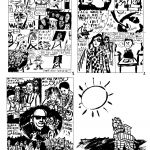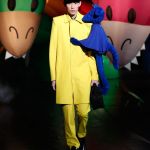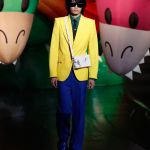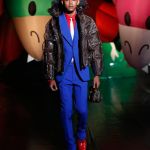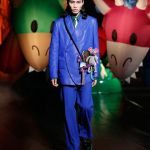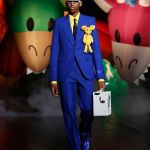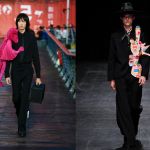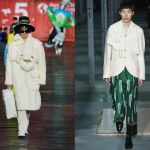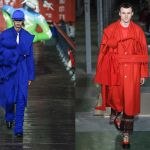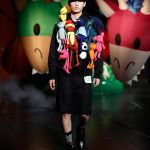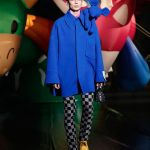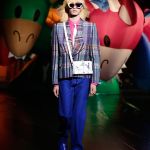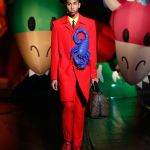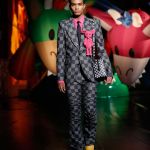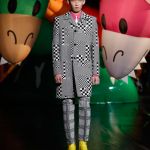
The controversy of Louis Vuitton's monogrammed teddy bear
Virgil Abloh, Marc Jacobs, Walter Van Beirendonck and the controversy over Louis Vuitton's latest design collection
September 3rd, 2020
Yesterday the new Louis Vuitton show for the SS21 season was held in Tokyo – which was the second part of the touring show program with which the French brand decided to present its new collection to the Asian market. The show was opened by a white-suited model holding a teddy bear – a direct reference to the brand's SS05 collection. The teddy bear has a strong symbolic value, because it represents Virgil Abloh's defense of the plagiarism allegations made against him by Walter Van Beirendonck after the first of the traveling shows of Shanghai Vuitton whose garments seemed to be taken of weight from the lookbooks of the former Antwerp Six member. Van Beirendonck's accusations have been heavy but not out of place: both the toy accessories in the collection, as well as the asymmetrical sunglasses and cartoonish lapels of certain looks resemble in all respects Van Beirendonck's previous designs. The issue has reopened the long-standing controversy over Abloh's creative processes, his "3% rule" and his originality as a designer.
The audience has split between Abloh partisans (including Kanye West) who have defended their hero at sword-drawn and van Beirendonck's allies, former Louis Vuitton creative director Marc Jacobs has made his voice heard. Under the teddy bear image posted by Abloh on Instagram yesterday, the American designer left a comment detailing how the bear was designed by the brand's then menswear designer, Keith Warren, who was inspired by the LGBT-themed novel Brideshead Revisited, in which a stuffed bear is one of the core elements of the plot. A neutral but ambiguous comment that added more elements in a thorny issue for Abloh – whose entire show yesterday tasted like a claim of autorship and originality. The controversy then shifted to a different terrain: riding the wave of political correctness that dominates today's public discourse, some partisan publishers as well as Virgil himself have made plagiarism a racial issue even going so far as to counter-accuse Van Beirendonck of cultural appropriation of African and Eastern culture in his previous parades.
Having become the exonerating evidence for Abloh, as well as a symbol of a particularly resentful clash of creatives, the teddy bear appeared on the catwalk "with a pounding insistence that has a bit of a straw tail", to quote the words of Angelo Flaccavento, who commented on the show on the pages of Il Sole 24 Ore. To increase the dose, Abloh accompanied the show with a literal seven-page essay on how his African ancestry had inspired the use of puppets, from a three-page manifesto written by Abloh himself in response to events, and also by an amateur comic that emphasizes the point for the third time. Needless to say, trasforming the traditional show notes (usually one or two pages long) into a polemical pamphlet of 83 pages, feels like an overkill: many other times Abloh has been accused of creative appropriation, but this time it seemed almost unsettled by them. A sheet of vague but undoubtedly tendentious questions was also attached to the show notes, which wanted to drag the issue culturally and racially, with questions such as: "What are the residual effects of colonialism?" or "Who owns my ancestry?" and "What is a coincidence?"
And although fashion has had in the past and still has serious and profound problems with the complex issue of neo-colonialism (expressed through the survival of gadgets and iconography inspired by a culture whose assumptions were necessarily racist), the Abloh vs. Van Beirendonck lawsuit has nothing to do with the colonial question. In an op-ed by Ruba Abu-Nimah recently published in Highsnobiety, the creative director writes: "In recent weeks, as a result of the Black Lives Matter movement, people in Belgium have started reexamining the country’s colonial history, and statues of King Leopold II have been torn down. Van Beirendonck as an artist and educator has a responsibility to participate in this reexamination." There is a clear logical fallacy in this reasoning: the problem of Belgium with its shameful colonial history is a state argument for which the government of the country has yet to apologise, but it is not Van Beirendonck's personal responsibility – who in any case accused Abloh of copying his work, not appropriating this or that culture.
Race baiting aside, the narrative pushed insistently by Abloh's partisans would like to paint him as a kind of underdog of fashion – a new name, just arrived on the scene and mistreated by an industry of traditionalists that would keep him closed all doors. But the truth is that Abloh has been starring in the highest echelons in fashion since 2012 when he created Pyrex Vision – which, among other things, quickly ended in controversy for using Ralph Lauren's classic flannels by painting their back with graphics and selling them at 550$ as if they were an original design. A year later that brand became Off-White, which is also the most sought after brand in the world according to Lyst, and five years later Abloh came from Louis Vuitton. Not quite the story of underdog opposed by the world. On the other hand, there is Van Beirendonck, who has had an equally glorious career, but whose brand has always remained a niche phenomenon, has never suffered accusations of plagiarism and cannot be compared, in terms of popularity and commercial success, neither Louis Vuitton nor Off-White. If there is an underdog or a victim in this story, in short, it is definitely not the creative director of two of the richest and most important fashion houses in the world.
















































